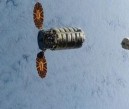PH’s first microsatellite Diwata-1 decommissioned
MANILA, Philippines – Diwata-1, the Philippines’ first microsatellite for scientific earth observation built by Filipino scientists, has been officially decommissioned after reentering the Earth’s atmosphere.
The Stamina 4 Space Program of the University of the Philippines said in a statement on Tuesday that they started monitoring the status of Diwata-1 a few months ago, after noticing that its altitude dropped. It also noted that the microsatellite had no propulsion mechanism to move to another spot.
Despite this, it exceeded its initial slated lifespan of 18 months, feeding scientists with data for almost four years.

This still image taken from NASA TV shows a commercial cargo ship named Cygnus about to connect to the International Space Station on Saturday, March 26, 2016. It’s the first of three shipments coming up in quick succession. A Russian cargo ship will lift off in a few days, followed by a SpaceX supply run on April 8. NASA has turned to private industry to keep the space station stocked. (NASA via AP)
“The status of Diwata-1 was being closely monitored by the STAMINA4Space program over the past few months as its altitude continued to decrease. The altitude of a satellite in Low Earth Orbit (LEO) is expected to decay over time and, in the case of Diwata-1, there is no propulsion mechanism to keep it in orbit,” Stamina 4 Space said.
“Diwata-1 is expected to de-orbit and burn up due to increasing friction with the atmosphere, ultimately ending its service to the country. Initially forecast to spend 18 months in orbit, Diwata-1’s orbital lifetime lasted almost four years,” they added.
During its lifespan, Diwata-1 was tasked for an earth observation mission, which included studying the extent of damages caused by natural disasters, “assessing changes in vegetation and ocean productivity, and capturing large scale cloud patterns.”
It was built by Filipino engineers and scientists from the University of the Philippines-Diliman, in collaboration with Japanese universities, Tohoku University and Hokkaido University. It was also backed by the Department of Science and Technology (DOST).
Diwata-1 was launched into the International Space Station from Atlas V Rocket in Florida, USA, on March 23, 2016.
“During its scientific earth observation mission, Diwata-1 contributed to advancements in the Philippines’ space technology landscape. As a platform for technology demonstration and experimentation, Diwata-1 enabled Filipino researchers to conduct hands-on and in-depth mission planning, design, integration, testing and operation of an earth observation satellite,” Stamina 4 Space explained.
“Diwata-1 covered 114,087 km. sq. of the Philippines’ land, or roughly 38.0%. Diwata-1 also orbited approximately 22,643 times around the Earth and passed by the Philippines roughly 4,800 times,” they added.
Also, Stamina 4 Space said Diwata-1 served as a blueprint for other satellite releases including the Maya-1, the nanocube satellite launched in August 2018 tasked to help scientists create geohazard maps.